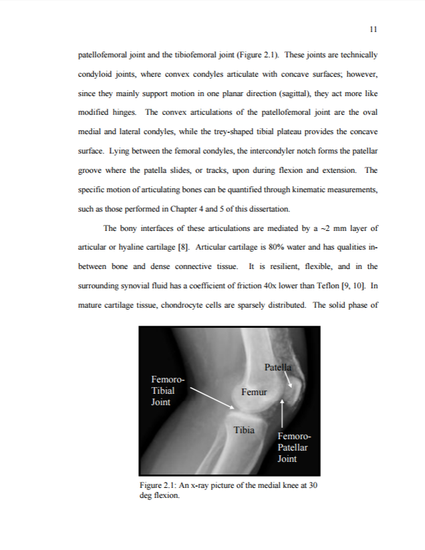
Dissertation
Multiscale Biomechanical Relationships in Ligament
(2007)
Abstract
Healthy knee joints require structural stability through a full range of motion. Knee stability is primarily provided by a network of ligaments that resist abnormal forces and direct smooth articulations. Ligament malfunction has deleterious effects on balance, agility, and knee laxity. Altered knee laxity redistributes the stress transmitted across articulations, which may create regional stress concentrations that are potentially damaging to articular cartilage. The high incidence of knee ligament injuries and shortfalls of related treatments are thus adverse to knee joint health. As the function of ligament is essentially mechanical, understanding the tissue-scale and molecular-scale relationships that mechanically influence ligament are critical to functional restoration. The aim of this dissertation was to strengthen the scientific knowledge of mechanical relationships that impact ligament function in the knee. Toward this objective, a tissuescale relationship was investigated between the anterior cruciate ligament (ACL) and the medial collateral ligament (MCL). These knee ligaments are frequently injured and have inter-dependent functionality. At the molecular-scale, mechanical interactions between glycosaminoglycans (GAGs) and collagen fibrils may impact gross ligament function. Therefore, the influence of these molecular relationships on ligament material behavior was inspected.
Experimental and numerical modeling techniques (finite element analysis) were employed to fulfill these objectives. In an ACL-deficient knee, the MCL was more susceptible to damage during anterior tibial translation, as strains reached values v corresponding to the threshold of microstructural failure. The MCL mid-substance and insertions were functionally insensitive to ACL transection during valgus loading of the knee. Interfibrillar GAGs were found to have negligible influence on tissue-scale mechanics during tensile loading. Therefore, interfibrillar GAGs do not directly support ligaments primary function of resisting tensile loads, which contradicts the popular theory that GAGs transmit forces between adjacent collagen fibrils. By determining the effect of multiscale relationships on ligament function, improvements are possible in the innovation and evaluation of ligament treatment modalities.
Disciplines
Publication Date
December, 2007
Degree
Doctor of Philosophy
Field of study
Bioengineering
Department
Department of Bioengineering
Comments
Copyright © Trevor Justin Lujan 2007 All Rights Reserved
Citation Information
Trevor J. Lujan. 2007. "Multiscale Biomechanical Relationships in Ligament" Dissertation/Department of Bioengineering/The University of Utah
